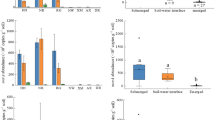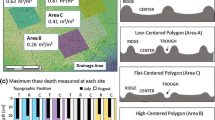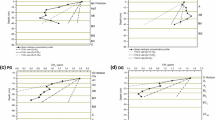Abstract
Subsoil CH4 and CO2 concentrations, δ13C-CH4 and δ13C-CO2 signatures, total organic carbon (TOC) and δ13C-TOC, together with C/N ratio of organic matter, were evaluated throughout a soil profile up to the atmosphere to understand the dynamics of CH4 and CO2 in the waterlogged environment of an island of the Lower Delta of the Paraná River, Argentina. The analysis of the vertical profile showed that a significant fraction of CH4 exists as gas trapped within the sediment column, compared to CH4 dissolved in soil solution. CH4 concentration measurements in sub-saturated soils showed that free CH4 is 1 order of magnitude smaller than CH4 recovered from soil cores by ultrasonic degassing. The highest concentrations of CH4 occurred at the 90–120-cm layer. At this depth, δ13C-CH4 values resulting from methanogenesis were around − 71‰, which is well within the range of CH4 produced from CO2 reduction, and δ13C values of the associated CO2 were enriched (~ − 7‰). Isotope mass balance models used to calculate the fraction of oxidized CH4 indicated that around 30% of the CH4 produced was oxidized prior to atmospheric release. In contrast to methanogenesis, during oxidation processes δ13C-CH4 shifts to more positive values. The mineralogical, textural, isotopic, and geochemical characterization of subsoil sediments with abundant organic matter, like Paraná Delta, demonstrated that CH4 storage capacity of the soil, production, consumption, and transport are the main factors in regulating the actual flux rates of CH4 to the atmosphere.





Similar content being viewed by others
References
Aravena, R., Warner, B. G., Charman, D. J., Belyea, L. R., Mathur, S. P., & Dinel, H. (1993). Carbon isotopic composition of deep carbon gases in an ombrogeneous peatland, northwestern Ontario, Canada. Radiocarbon, 35, 271–276. https://doi.org/10.1017/S0033822200014016.
Badeck, F. W., Tcherkez, G., Nogués, S., Piel, C., & Ghashghaie, J. (2005). Post-photosynthetic fractionation of stable carbon isotopes between plant organs—a widespread phenomenon. Rapid Communications in Mass Spectrometry, 19, 1381–1391. https://doi.org/10.1002/rcm.1912.
Baird, A. J., Beckwith, C. W., Waldron, S., & Waddington, J. M. (2004). Ebullition of methanecontaining gas bubbles from near surface Sphagnum peat. Geophysical Research Letters, 31, L21505. https://doi.org/10.1029/2004GL021157.
Beckwith, C. W., & Baird, A. J. (2001). Effect of biogenic gas bubbles on water flow through poorly decomposed blanket peat. Water Resources Research, 37(3), 551–558.
Bergamaschi, P. (1997). Seasonal Variation of Stable Hydrogen and Carbon Isotope Ratios in Methane from a Chinese Rice Paddy. Journal of Geophysical Research, 102(D21), 25,383–25,393. https://doi.org/10.1029/97JD01664.
Bernard, B. B., Brooks, J. M., & Sackett, W. M. (1978). Light hydrocarbons in recent Texas continental shelf and slope sediments. Journal of Geophysical Research, 83, 4053. https://doi.org/10.1029/JC083iC08p04053.
Biscaye, P. E. (1965). Mineralogy and sedimentation of recent deep-sea clay in the Atlantic Ocean and adjacent seas and oceans. Bulletin Geological Society of America, 76, 803. https://doi.org/10.1130/0016-7606(1965)76[803:MASORD]2.0.CO;2.
Bridgham, S. D., Cadillo-Quiroz, H., Keller, J. K., & Zhuang, Q. (2013). Methane emissions from wetlands: biogeochemical, microbial, and modeling perspectives from local to global scales. Global Change Biology, 19, 1325–1346. https://doi.org/10.1111/gcb.12131.
Chanton, J. P. (2005). The Effect of Gas Transport on the Isotope Signature of Methane in Wetlands. Organic Geochemistry, 36, 753–768. https://doi.org/10.1016/j.orggeochem.2004.10.007.
Chanton, J. P., Martens, C. S., & Kelley, C. A. (1989). Gas transport from methane-saturated tidal fresh-water and wetland sediments. Limnology and Oceanography, 34, 807–819. https://doi.org/10.4319/lo.1989.34.5.0807.
Clark. (2015). Groundwater geochemistry and isotopes. Boca Raton, Florida: CRC Press.
Coleman, D. D., Risatti, J. B., & Schoell, M. (1981). Fractionation of Carbon and Hydrogen Isotopes by Methane-Oxidizing Bacteria. Geochimica et Cosmochimica Acta, 45, 1033–1037. https://doi.org/10.1016/0016-7037(81)90129-0.
Coleman D. D., Liu, C. L., Hackley, K. C. & Benson, L. J. (1993). Identification of Landfill Methane Using Carbon and Hydrogen Isotope Analysis. Proceedings of 16th International Madison Waste Conference, Municipal & Industrial Waste (pp. 303–314). Madison: Department of Engineering Professional Development, University of Wisconsin, 22-23 September.
Comas, X., Slater, L., & Reeve, A. (2005). Spatial Variability in Biogenic Gas Accumulations in Peat Soils Is Revealed by Ground Penetrating Radar (GPR). Geophysical Research Letters, 32, L08401. https://doi.org/10.1029/2004gl022297.
Comas, X., Kettridge, N., Binley, A., Slater, L., Parsekian, A., Baird, A. J., Strack, M., & Waddington, J. M. (2014). The effect of peat structure on the spatial distribution of biogenic gases within bogs. Hydrological Processes, 28, 5483–5494. https://doi.org/10.1002/hyp.10056.
Conrad, R. (2005). Quantification of methanogenic pathways using stable carbon isotopic signatures: a review and a proposal. Organic Geochemistry, 36, 739–752. https://doi.org/10.1016/j.orggeochem.2004.09.006.
Coplen, T. B., Brand, W. A., Gehre, M., Gröning, M., Meijer, H. A. J., Toman, B., & Verkouteren, R. M. (2006). New guidelines for δ13C measurements. Analytical Chemistry, 78, 2439–2441. https://doi.org/10.1021/ac052027c.
Coulthard, T. J., Baird, A. J., Ramirez, J., & Waddington, J. M. (2009). Methane dynamics in peat: importance of shallow peats and a novel reduced-complexity approach for modeling ebullition. In A. J. Baird, L. R. Belyea, X. Comas, A. S. Reeve, & L. D. Slater (Eds.), Carbon cycling in northern peatlands (pp. 173–185). Washington DC: American Geophysical Union.
Couwenberg, J., Dommain, R., & Joosten, H. (2010). Greenhouse gas fluxes from tropical peatlands in south-east Asia. Global Change Biology, 16, 1715–1732. https://doi.org/10.1111/j.1365-2486.2009.02016.x.
De Visscher, A., De Pourcq, I., & Chanton, J. (2004). Isotope Fractionation Effects by Diffusion and Methane Oxidation in Landfill Cover Soils. Journal of Geophysical Research, 109, D18111. https://doi.org/10.1029/2004jd004857.
Dorodnikov, M., Marushchak, M., Biasi, C., & Wilmking, M. (2013). Effect of microtopography on isotopic composition of methane in porewater and efflux at a boreal peatland. Boreal Environment Research, 18, 269–279.
EPA (2001). Wetlands Classification and Types. Resource document. Environmental Protection Agency of United States, Office of Water EPA 843-F-01-002b, Oceans and Watersheds (4502T). http://water.epa.gov/type/wetlands/types_index.cfm
Gal’chenko, V. F., Lein, A., & Ivanov, M. V. (2004). Methane content in the bottom sediments and water column of the Black Sea. Microbiology, 73(2), 211–223.
Garnett, M. H., Hardie, S. M. L., & Murray, C. (2011). Radiocarbon and stable carbon analysis of dissolved methane and carbon dioxide from the profile of a raised peat bog. Radiocarbon, 53, 71–83. https://doi.org/10.1017/S0033822200034366.
Glaser, P. H., Chanton, J. P., Morin, P., Rosenberry, D. O., Siegel, D. I., Ruud, O., Chasar, L. I., & Reeve, A. S. (2004). Surface Deformations as Indicators of Deep Ebullition Fluxes in a Large Northern Peatland. Global Biogeochemical Cycles, 18, GB1003. https://doi.org/10.1029/2003gb002069.
Hackley, K. C., Coleman, D. D., & Liu, C. L. (1996). Environmental isotope characteristics of landfill leachates and gases. Groundwater, 34, 827–836. https://doi.org/10.1111/j.1745-6584.1996.tb02077.x.
Hackley, K. C., Liua, C. L., & Trainorb, D. (1999). Isotopic identification of the source of methane in subsurface sediments of an area surrounded by waste disposal facilities. Applied Geochemistry, 14, 119–131. https://doi.org/10.1016/S0883-2927(98)00036-5.
Hapell, J. D., Chanton, J. P., & Showers, W. J. (1995). Methane transfer across the water-air interface in stagnant wooded swamps of Florida: evaluation of mass transfer coefficients and isotopic fractionation. Limnology and Oceanography, 40, 290–298.
Hornibrook, E. R. C., Longstaffe, W. S., & Fyfe, W. S. (1997). Spatial distribution of microbial methane production pathways in temperate zone wetland soils: stable carbon and hydrogen isotope evidence. Geochimica et Cosmochimica Acta, 61, 745–753.
Hornibrook, E. R. C., Longstaffe, F. J., & Fyfe, W. S. (2000). Evolution of stable carbon isotope compositions for methane and carbon dioxide in freshwater wetlands and other anaerobic environments. Geochimica et Cosmochimica Acta, 64, 1013–1027.
INTA. (1990). Atlas de Suelos de la República Argentina. Buenos Aires: Instituto de Suelos-INTA.
Kandus, P., Quintana, R. D., & Bó, R. F. (2006). Patrones de Paisaje y Biodiversidad del Bajo Delta del Río Paraná. Mapa de Ambientes. Buenos Aires: Pablo Casamajor.
Kayranli, B., Scholz, M., Mustafa, A., & Hedmark, A. (2010). Carbon storage and fluxes within freshwater wetlands: a critical review. Wetlands, 30, 111–124. https://doi.org/10.1007/s13157-009-0003-4.
Khalil, M. (2000). Atmospheric methane: an introduction. In M. A. K. Khalil (Ed.), Atmospheric methane. Its role in the global environment (pp. 1–8). New York: Springer.
Khan, N. S., Vane, C. H., & Horton, B. P. (2015). Stable carbon isotope and C/N geochemistry of coastal wetland sediments as sea-level indicator. In I. Shennan, A. J. Long, & B. P. Horton (Eds.), Handbook of sea-level research (pp. 295–311). New Jersey: John Wiley & Sons Ltd..
Lai, D. Y. (2009). Methane dynamics in northern peatlands: a review. Pedosphere, 19, 409–421. https://doi.org/10.1016/S1002-0160(09)00003-4.
Le Mer, J., & Roger, P. (2001). Production, oxidation, emission and consumption of methane by soils: a review. European Journal of Soil Biology, 37, 25–50. https://doi.org/10.1016/S1164-5563(01)01067-6.
Liptay, K., Chanton, J., Czepiel, P., & Mosher, B. (1998). Use of stable isotopes to determine methane oxidation in landfill cover soils. Journal of Geophysical Research, 103, 8243–8250. https://doi.org/10.1029/97JD02630.
Magen, C., Lapham, L., Pohlman, J. W., Marshall, K., Bosman, S., Casso, M., & Chanton, J. P. (2014). A simple headspace equilibration method for measuring dissolved methane. Limnology and Oceanography: Methods, 12, 637–650. https://doi.org/10.4319/lom.2014.12.637.
Malvárez, A. I. (1997). Las comunidades vegetales del Delta del río Paraná. Su relación con factores ambientales y patrones de paisaje. Tesis Doctoral. Universidad de Buenos Aires. Argentina.
Martens, C. S., Kelley, C. A., Chanton, J. P., & Showers, W. J. (1992). Carbon and hydrogen isotopic characterization of methane from wetlands and lakes of the Yukon-Kuskokwim delta, western Alaska. Journal of Geophysical Research, 97, 16689. https://doi.org/10.1029/91JD02885.
Medina, R. A., & Codignotto, J. O. (2013). Evolución del delta del río Paraná y su posible vinculación con el calentamiento global. Revista Museo Argentino Ciencias Naturales, 15(2), 191–200.
Preuss, I., Knoblauch, C., Gebert, J., & Pfeiffer, E. M. (2013). Improved quantification of microbial CH4 oxidation efficiency in arctic wetland soils using carbon isotope fractionation. Biogeosciences, 10, 2539–2552. https://doi.org/10.5194/bg-10-2539-2013.
Ramirez, J. A., Baird, A. J., Coulthard, T. J., & Waddington, J. M. (2015). Ebullition of methane from peatlands: does peat act as a signal shredder? Geophysical Research Letters, 42, 3371–3379. https://doi.org/10.1002/2015GL063469.
Rosenberry, D. O., Glaser, P. H., & Siegel, D. I. (2006). The hydrology of northern peatlands as affected by biogenic gas: current developments and research needs. Hydrological Processes, 20, 3601–3610. https://doi.org/10.1002/hyp.6377.
Sanci, R., & Panarello, H. O. (2016). Carbon stable isotopes as indicators of the origin and evolution of CO2 and CH4 in urban solid waste disposal sites and nearby áreas. Environmental Earth Sciences, 75, 294. https://doi.org/10.1007/s12665-015-4906-5.
Sanci, R., Panarello, H., & Ostera, H. (2012). CO2 emissions from a municipal site for final disposal of solid waste in Gualeguaychú, Entre Ríos Province, Argentina. Environmental Earth Sciences, 66, 519–528. https://doi.org/10.1007/s12665-011-1260-0.
Schmitt, M., Faber, E., Botz, R., & Stoffers, P. (1991). Extraction of methane from seawater using ultrasonic vacuum degassing. Analytical Chemistry, 63(5), 529–532.
Schumacher, B. A. (2002). Methods for the determination of total organic carbon (TOC) in soils and sediments. Resource document, United States Environmental Protection Agency, NCEA-C- 1282 EMASC-001. http://bcodata.whoi.edu/LaurentianGreatLakes_Chemistry/bs116.pdf. Accessed 21 Feb 2014
Scranton, M. I., Donaghay, P., & Sieburth, J. M. (1995). Nocturnal methane accumulation in the pycnocline of an anoxic estuarine basin. Limnology and Oceanography, 40, 666–672. https://doi.org/10.4319/lo.1995.40.4.0666.
Steinmann, P., Eilrich, B., Leuenberger, M., & Burns, S. J. (2008). Stable carbon isotope composition and concentrations of CO2 and CH4 in the deep catotelm of a peat bog. Geochimica et Cosmochimica Acta, 72, 6015–6026. https://doi.org/10.1016/j.gca.2008.09.024.
Strack, M., Waddington, J. M., & Tuittila, E. S. (2004). Effect of water table drawdown on northern peatland methane dynamics: implications for climate change. Global Biogeochemical Cycles, 18, GB4003. https://doi.org/10.1029/2003GB002209.
Strack, M., Kellner, E., & Waddington, J. M. (2005). Dynamics of Biogenic Gas Bubbles in Peat and Their Effects on Surface Deformations as Indicators of Deep Ebullition Fluxes in a Large Northern Peatland. Global Biogeochemical Cycles, 19, GB1003. https://doi.org/10.1029/2004GB002330.
Teh, Y. A., Silver, W. L., & Conrad, M. E. (2005). Oxygen effects on methane production and oxidation in humid tropical forest soils. Global Change Biology, 11, 1283–1297. https://doi.org/10.1111/j.1365-2486.2005.00983.x.
Waldron, S., Hall, A. J., & Fallick, A. E. (1999). Enigmatic stable isotope dynamics of deep peat methane. Global Biogeochemical Cycles, 13, 93–100. https://doi.org/10.1029/1998GB900002.
Wassmann, R., Neue, H. U., Alberto, M. C. R., Lantin, R. S., Bueno, C., Llenaresas, D., Arah, J. R. M., Papen, H., Seiler, W., & Rennenberg, H. (1996). Fluxes and Pools of Methane in Wetlands Rices Oils with Varying Organic Inputs. Environmental Monitoring and Assessment, 42, 163–173. https://doi.org/10.1007/BF00394048.
Werth, M., & Kuzyakov, Y. (2010). 13C fractionation at the root–microorganisms–soil interface: a review and outlook for partitioning studies. Soil Biology and Biochemistry, 42, 1372–1384. https://doi.org/10.1016/j.soilbio.2010.04.009.
Whalen, S. C. (2005). Biogeochemistry of methane exchange between natural wetlands and the atmosphere. Environmental Engineering Science, 22, 73–94. https://doi.org/10.1089/ees.2005.22.73.
Whiticar, M. J. (1999). Carbon and hydrogen isotope systematics of bacterial formation and oxidation of methane. Chemical Geology, 161, 291–314. https://doi.org/10.1016/S0009-2541(99)00092-3.
Whiticar, M. J., Faber, E., & Schoell, M. (1986). Biogenic methane formation in marine and freshwater environments: CO2 reduction vs. acetate fermentation—isotope evidence. Geochemica et Cosmochimica Acta, 50, 693–709.
Wuebbles, D. J., & Hayhoe, K. (2002). Atmospheric methane and global change. Earth-Science Reviews, 57, 177–210. https://doi.org/10.1016/S0012-8252(01)00062-9.
Zhang, T., & Krooss, B. M. (2001). Experimental investigation on the carbon isotope fractionation of methane during gas migration by diffusion through sedimentary rocks at elevated temperature and pressure. Geochemica et Cosmochimica Acta, 65, 2723–2742.
Acknowledgments
The authors are grateful to Stable Isotopes Laboratory staff members, Liliana Marban, Estela Ducos, Fernanda Cravero and Gabriel Giordarengo.
Funding
This research was supported by the Instituto de Geocronología y Geología Isotópica (UBA-CONICET).
Author information
Authors and Affiliations
Corresponding author
Rights and permissions
About this article
Cite this article
Sanci, R., Panarello, H.O. Distribution and isotopic signature of deep gases in submerged soils in an island of the Lower Delta of the Paraná River, Argentina. Environ Monit Assess 190, 647 (2018). https://doi.org/10.1007/s10661-018-7026-3
Received:
Accepted:
Published:
DOI: https://doi.org/10.1007/s10661-018-7026-3




